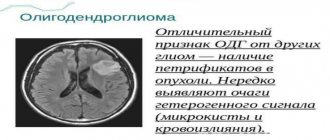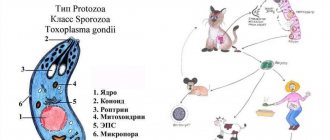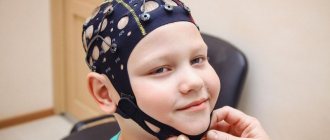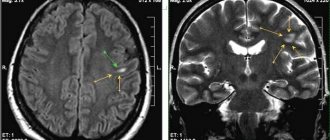A tumor in the brain is a serious and dangerous pathology in which brain cells degenerate into malignant ones. It can lead to irreversible disorders of brain activity and a significant deterioration in quality of life. Treatment of a brain tumor should begin as early as possible to avoid serious abnormalities. It must be modern, accurate and efficient. This requires innovative equipment and drugs, as well as an experienced and properly qualified specialist. Our center is provided with all this.
Signs of developing a brain tumor
The primary clinical picture is unremarkable, so it is almost impossible to detect cancer. The first signs appear when the tumor has already reached a significant size and compresses healthy brain tissue. Symptoms of malignancy depend on its location:
- Occipital lobe: Loss or deterioration of vision in one eye, and vision may become blurred.
- Frontal region: behavioral disorders, character changes.
- Cerebellum: loss of coordination, nausea and vomiting, weakened muscle fibers at the back of the head, involuntary movements of the eyeballs.
- Parietal lobe: loss of coordination, difficulty speaking and understanding speech.
- Brain stem: bifurcation of the visible image, poor orientation in space, difficulty swallowing, slurred speech, unsteady gait.
- Temporal region: memory impairment, unexplained feelings of fear or anxiety, frequent loss of consciousness, difficulty pronouncing words, hallucinations.
In addition, oncology may be accompanied by:
- partial or complete loss of sensation in the lower or upper extremities;
- general weakness;
- ringing in the ears;
- violation of writing;
- severe headache that is not relieved by medications, often worsening with sudden movements or changes in body position, as well as in the morning;
- problems maintaining balance;
- increased fatigue.
Find out the price
Find out the price
Error! Please fill in all required fields
Thank you! We will contact you shortly
✕
Can't fly to Turkey right now? Sign up for an online consultation with an Anadolu specialist.
What is stereotactic breast biopsy?
Masses or other abnormal changes in the breast can be detected by physical examination, mammogram, or other tissue imaging tests.
However, these studies do not always allow us to say about the benign or malignant nature of the neoplasm. During a breast biopsy, a sample of cells is removed from a suspicious area, either surgically or using a less invasive technique that involves the use of a hollow needle. The resulting sample is then examined under a microscope, allowing a diagnosis to be made. A puncture biopsy under visual control does not involve removing the entire pathological area, but only a small part of it.
An image-guided breast biopsy is performed in cases where the breast mass is too small to be felt with the fingers, that is, palpated.
During a stereotactic biopsy, a mammography machine that produces ionizing (X-ray) radiation helps the doctor bring instruments to the pathological area to collect a sample of breast tissue.
Up
Diagnosis of brain tumors
With the help of an initial examination, an experienced oncologist or neurologist determines the most obvious symptoms of brain damage. To do this, the patient's coordination, behavior, sensitivity to pain, and various reflexes are tested. To determine the presence of a malignant formation, laboratory and instrumental diagnostic techniques are also used:
- radiography;
- checking blood for tumor markers;
- angiography;
- vision check by an ophthalmologist;
- magnetic resonance, positron emission or computed tomography;
- spinal tap;
- Ultrasound;
- electroencephalography.
A histological analysis of tumor tissue provides a 100% accurate examination result. If the brain is affected by a malignant process, performing a biopsy becomes a complex neurosurgical intervention. It can be performed using a craniotomy or stereotactically, where a needle is inserted into a small hole and monitored by a computer.
Types of diagnostics
There are these types of biopsies:
- Stereotactic brain biopsy. This type of tissue collection is used for hard-to-reach areas of the brain. Typically, stereotactic biopsy is performed using a special installation - a stereotactic system, equipped with a coordinating frame and the possibility of three-dimensional orientation. The structure of the device allows you to choose the safest trajectory and entry point. To increase accuracy, stereotactic biopsy is performed under the guidance of magnetic resonance or computed tomography.
- Needle biopsy. A hole is drilled in the skull through which a puncture needle is inserted to excise the tissue.
- Open biopsy.
It is performed during brain surgery.
Treatment of cancer in Anadolu
The main treatment method is surgery to remove the tumor. Small tumors are eliminated using microsurgical methods under the control of computer navigation. Large formations require craniotomy with opening of the skull. Malignant tumors in the pituitary gland can be removed through the nasal passages. One of the popular modern methods is stereotactic radiosurgery without harm to healthy cells, which is performed using the most precise equipment: Varian Edge (new generation TureBeam) or CyberKnife. Our clinic is equipped with a unique hybrid operating room.
Chemotherapy for brain cancer or radiation irradiation of the tumor can be used as auxiliary techniques.
Medical provides patients with a level of service that meets all international standards. Unlike domestic institutions, our clinic helps patients with any type of cancer, including complex and advanced cases of its development. Doctors with professionalism and an individual approach to each patient achieve impressive results. At the same time, the cost of a treatment course is significantly lower than in other world medical centers, which does not in any way affect the quality of services.
A brain tumor is a malignant formation that requires early and accurate diagnosis, as well as complex neurosurgical surgery. This is one of the most dangerous diseases in medicine, which can lead to irreversible disorders of brain activity. Considering the seriousness of the problem, it is better to contact a foreign clinic, which is significantly superior in its capabilities to domestic institutions. This will ensure that treatment of a brain tumor will lead to a significant improvement in the patient’s well-being.
Qualified medical assistance from doctors allows you to promptly identify pathology and select the most effective health course. The high level of development of medicine increases the chances of recovery even in the most difficult cases.
First use of new technology
At a time when neuro-oncologists around the world are reconsidering approaches to the treatment of high-grade brain tumors and are increasingly turning to targeted therapy, which is selected in accordance with specific mutations of cancer cells, there is a growing need to monitor tumor growth and its response to treatment,” says senior study author Dr. Javad Nazarian of Children's National Medical Center in Washington.
According to the scientist, in order to select the optimal, tumor-specific type of therapy, it is necessary to regularly monitor the progression of the tumor and monitor the genetic changes that occur during its development. “Circulating tumor DNA is now increasingly used for disease control in adult patients diagnosed with cancer, including glioblastoma (brain tumor), melanoma, lung, colon and breast cancer. However, this is the first time it has been used in the diagnosis and treatment of childhood brain tumors,” says the doctor.
He notes that the use of advanced technologies will allow doctors to develop personalized treatment for the most vulnerable category of patients.
The scientists also studied a subgroup of patients with a particularly dangerous form of diffuse brainstem glioma. In an experiment conducted by the Pacific Pediatric Neuro-Oncology Consortium, led by Dr. Muller, they examined only plasma samples, where the concentration of circulating tumor DNA is typically lower than in the cerebrospinal fluid, and found a specific type of mutation in 16 of 20 samples - exactly the same data as obtained using standard biopsy.
Nine children with a dangerous form of diffuse brainstem glioma in the progressing stage underwent personalized treatment using drugs selected according to the mutations identified using liquid biopsy. The therapy led to a reduction in the amount of circulating tumor DNA, indicating a decrease in tumor volume - a reduction in the number of markers was subsequently confirmed by magnetic resonance imaging.
Brain tumor symptoms
Signs of the disease can vary, depending on the size of the tumor, its location and the pressure on surrounding tissue. When located in a certain part of the brain, certain functions are disrupted. Among the main symptoms of cancer:
- complete or partial loss of sensation in the limbs;
- nausea and vomiting;
- blurred vision (a veil may appear before the eyes);
- general weakness, fatigue;
- double vision;
- frequent headaches of varying intensity and character, sometimes it can intensify with changes in body position or sudden movements;
- disturbance of normal speech;
- problems with spatial orientation and balance.
In later stages, cancer may present with personality changes and confusion.
How is brain cancer diagnosed?
The Anadolu Clinic conducts a high-quality examination of patients using laboratory, instrumental and visual techniques. The latest generation equipment gives accurate results at any stage of tumor development. The brain needs to be checked regularly so that the disease can be detected at an early stage. The main types of diagnostics that a doctor can prescribe:
- computed and magnetic resonance imaging;
- radiography;
- single photon emission computed tomography (SPECT);
- ultrasonography;
- angiography;
- lumbar puncture;
- electroencephalography;
- blood test for tumor markers;
- biopsy;
- vision check by an ophthalmologist;
- myelography.
The biopsy is carried out in two ways: with a conventional craniotomy or a stereotactic method, when a needle is inserted into a small hole in the head and controlled by computer navigation.
Diagnosis, treatment
All three types of oligodendroglioma have similar diagnostic and treatment methods.
The tumor is most often detected by computed tomography and magnetic resonance imaging using a contrast agent. A biopsy is also taken, electroencephalography, ultrasound of cerebral vessels, and audiography are done.
The main method of treatment is to remove the tumor (completely or remove most of the tumor). To do this, trepanation or resection is performed. It is best to remove the affected tissue completely if possible.
Next comes chemotherapy and radiation.
If the tumor cannot be removed, then radiation therapy is used and cytostatic drugs are prescribed.
How effective the treatment is depends on factors such as:
- Tumor size;
- Malignancy by degree;
- Character of behavior;
- Response to treatment;
- Type of operation;
- Individual characteristics and health status.
Gliosarcoma
Treatment of a brain tumor in medical
The main treatment method is surgery. For larger tumors, a craniotomy is performed to open the skull. Small tumors can be removed using a cranioscope. Cancer cells in the pituitary gland are eliminated using access through the nasal passages. Another method of surgical tumor removal is stereotactic radiosurgery. It is performed using high-precision equipment (Cyber Knife or TureBeam), so healthy cells are not harmed.
Additional treatment methods may include chemotherapy or radiation, as well as their combination. They are also effective in the fight against metastases. Chemotherapy drugs are injected intravenously or directly into the spinal column so that the effect affects only the central nervous system.
After successful removal of the pathological formation, patients undergo rehabilitation, which helps restore lost functions and feel better. Our specialists take on cases of any severity and do everything possible to prolong the life of patients and improve its quality.
The medical service provides reasonable prices for the entire range of cancer treatment services. It is significantly lower in other similar medical institutions in Europe, America and Turkey. You can find out what the approximate price of the wellness program will be from our specialists by phone or through the electronic form on the website.
The material was prepared in agreement with medical doctors.
Cost of treatment
| Name of service | price, rub. | Unit measurements |
| Consultation with an oncologist and radiotherapist | 1 500 | PC. |
| Consultation with a pediatric oncologist | 0 | PC. |
| Repeated consultation with specialists | 500 | PC. |
| Primary topometry on a specialized computed tomograph | 15 000 | procedure |
| Repeated topometry on a specialized computed tomograph | 7 000 | procedure |
| Primary dosimetric planning of radiation therapy (tomotherapy) | 20 000 | PC. |
| Repeated dosimetric planning of radiation therapy (tomotherapy) | 7 000 | PC. |
| Radiation therapy (tomotherapy), including IMGRT (*) | 315 000 | well |
| Radiation therapy (tomotherapy) stereotactic radiosurgery(*) | 315 000 | well |
| Accompanying drug therapy: intravenous administration in the treatment room (excluding the cost of medications) | 1 000 | procedure |
| Accompanying drug therapy: intramuscular administration in the treatment room (excluding the cost of medications) | 200 | procedure |
| Topometric marking | 750 | procedure |
The type of radiation therapy and the number of sessions of the course are determined by the medical commission individually for each patient based on the location, nosology of the tumor and taking into account the medical history.
Free online consultation
Sign up








